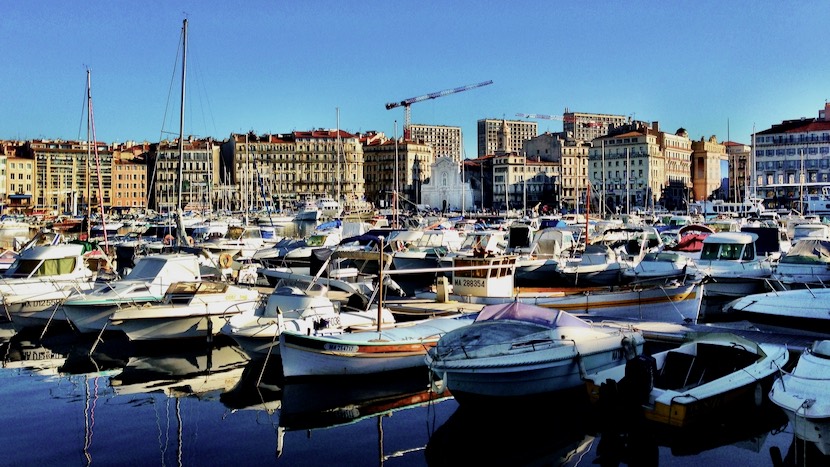Marseille is the second largest city in France by population (nestled between number one Paris and number three Lyon) with more than 870k residents. Situated just 32km (20-miles) to the south of Aix-en-Provence, this administrative and commercial capital of the Provence Alpes Côte d’Azur region is well worth a visit if your itinerary allows. In fact, Time Magazine included this “Mediterranean darling” in its 50 World’s Greatest Places 2022. Low-cost trains run regularly from the Aix-en-Provence station and buses also depart several times an hour, making for easy day trip commute options.
How To Get From Aix-en-Provence To Marseille?
Unless you’re brave, I don’t suggest driving your rental car as the streets can be a challenge to navigate and parking needlessly expensive. Instead, you can take either a bus or train from Aix to the Gare de Marseille-Saint-Charles station, and it’s just a short walk from there to the scenic Vieux Port, shopping areas, and restaurants. As with any large metropolitan city, some parts of Marseille can be a bit sketchy, and its gritty reputation for poverty and mafia activity is not exactly undeserved. But if you stay to the tourist areas (see my suggestions below), which are well-trafficked and safe, you’ll have an enjoyable day!
Brief History of Marseille
 This Mediterranean port city with an independent spirit dates back over 2,500 years to around 600BC when it was established as by seafaring Greek traders from Phocaea, aligning with the Romans a couple of centuries later yet maintaining its sovereignty until the Siege of Massilia in 49 BC when it was absorbed into the Roman Empire. Massalia, as it was known then, prospered as a maritime hub while also becoming an early center of Christianity until it fell to the Visigoths in the 5th century AD and spiraled into decline until the 10th century when it became part of the County of Provence and once again flourished. Unfortunately, the arrival of a trading ship carrying the bubonic plague from the east in the 14th century put an end to that – half the population (80,000) ultimately perished.
This Mediterranean port city with an independent spirit dates back over 2,500 years to around 600BC when it was established as by seafaring Greek traders from Phocaea, aligning with the Romans a couple of centuries later yet maintaining its sovereignty until the Siege of Massilia in 49 BC when it was absorbed into the Roman Empire. Massalia, as it was known then, prospered as a maritime hub while also becoming an early center of Christianity until it fell to the Visigoths in the 5th century AD and spiraled into decline until the 10th century when it became part of the County of Provence and once again flourished. Unfortunately, the arrival of a trading ship carrying the bubonic plague from the east in the 14th century put an end to that – half the population (80,000) ultimately perished.
The city’s fate once again rebounded during the mid-15th century under the rule of René of Anjou, Count of Provence, up until the Great Plague of Marseille in 1720. Although the epidemic lasted only a couple of years, it would take nearly a half-century for the economy to fully recover. At the end of the 18th century, Marseille became a center of activity in the French Revolution and the birthplace of France’s national anthem, La Marseillaise. The Industrial Revolution and establishment of the French Empire during the 19th century propelled further expansion of the city. In 2013, a series of architectural and infrastructure improvements were completed in advance of Marseille-Provence being celebrated as the European Capital of Culture.
Things to Do:
- Vieux Port – Hub of the city with hundreds of boats in the marina and fisherman selling their daily catch
- Notre-Dame de la Garde – Byzantine Cathedral located high above the city. Can be reached by tram or on foot from the Vieux Port, although it is a steep climb so be ready to get some exercise if you decide to walk. Well worth the effort.
- Château d’If – Made famous by Alexandre Dumas’ best-selling novel The Count of Monte Cristo. Ferries run regularly from the Vieux Port.
- Musée des Civilisations de l’Europe (MUSEM) – Museum dedicated to the Mediterranean
- Try the Bouillabaisse – Bouillabaisse is traditional Provençal fish stew originating in Marseille and a source of great pride for local restaurateurs.
- Fort Saint Jean – Completely renovated with a stunning walkway connecting it with Le Panier, Marseille’s oldest neighbourhood.
- La Friche – A former tobacco factory repurposed to a public space and working community with cultural arts, special events, shops, and gardens to enjoy.

